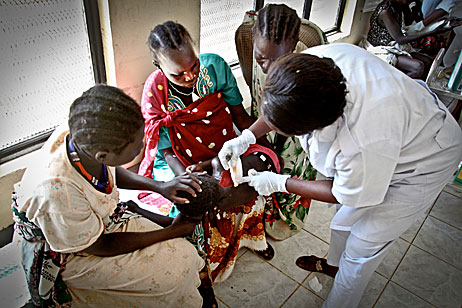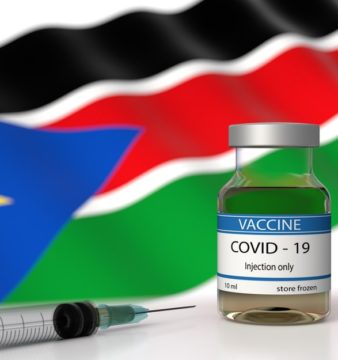South Sudan: New country, old health challenges

A child getting treated at the Juba Teaching Hospital in Juba, South Sudan. (Source: www.thenational.ae)
At Juba Teaching Hospital, the only referral health facility in South Sudan, the patients crowding around were getting impatient. There were a few doctors attending to the ever-increasing number of patients. Under the waiting area built of steel and a corrugated iron roof, the heat was becoming unbearable, despite the open structure. On the ceiling two old fans struggle to dissipate the heat. A mounted flat TV screen, which seemed out of place, could barely be heard over the cacophony of voices rising in the air.
In the corner by the entrance of the medical consultation room, a family crowded around a patient on a stretcher who has just been wheeled in but was yet to be seen by a doctor. The faces of the people around him were grim. A sad situation was building, their patience began to run out as no one had attended to their sick relative. It was like they had lost hope. One patient emerged from the door marked pharmacy, with his prescription sheet. Some drugs will have to be bought from the pharmacy across the street from the hospital.
The scene playing out at the accident and emergency department in Juba Teaching Hospital is a glimpse of the situation across the country. It is even worse in the outskirts of the country that are cut off by poor road infrastructure, where health services barely exist and are kilometers away from many citizens.
It is not easy to handle health in such a large country with a countless number of diseases. South Sudan is home to diseases that have disappeared from other parts of the world and new exotic ones. The feared diseases like the Ebola hemorrhagic fever, first discovered in South Sudan and Congo, lurks in the wild and could re-emerge any time. Guinea worm is still rampant; sleeping sickness is causing problems; flared epidemics of visceral leishmaniasis are rampant. A completely new disease dubbed the nodding syndrome, which affects children causing growth and mental retardation, has emerged in the western part of the country. Add leprosy and buruli ulcer to the mix and you have a recipe like no other.
With all these challenges, it is not surprising that all the health indicators are quite depressing: maternal mortality ratio of 2,054 to 100,000 live births is the highest in the world. The under-five mortality rate is 106 of 1,000 and the infant mortality rate is 84 of 1,000.
During this period South Sudan was languishing as a conflict zone, which had left more than three million people dead. Independence promised a new dawn of hope for the region, a hope that is slowly being replaced by desperation as new challenges emerge every day.
For the patients waiting to be seen at the Juba Teaching Hospital Outpatient Department, it is a matter of time before things start to get better, something they hope for. The efforts of government to tackle the myriad problems are yet to bear fruits. But for now, the struggle to deliver health services continues.




